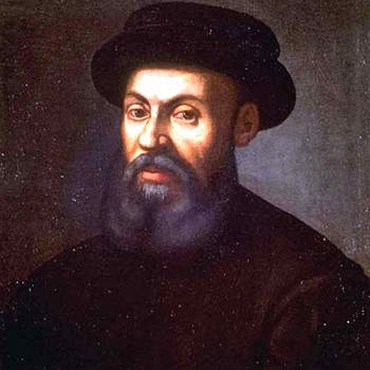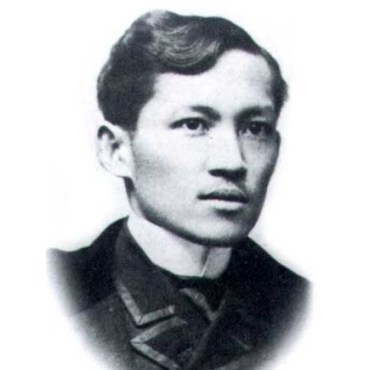History
The past of the Philippines
The past
When you ask Filipinos about their history, you either learn a bit about the very recent history, going back to maybe José Rizal or maybe to Ferdinand Marcos.
But more often you hear stories about "Kaiba-an", "Balang" and "Aswang", ghosts, phantoms and witches.
If you look for more scientific sources, you have to read lots of very thick books. But we found Wolfgang Bethge's website "Literaturbrücke Philippinen" in which the history of the Philippines can be found in form of 3 chronological tables.
We thank Wolfgang Bethge for his excellent work and are grateful that he allows us to use his history tables.
The 3 chronological tables are: First, from prehistoric era to the end of the Spanish colony. Second, from the beginning of the American colony to the end of the second world war. And third, from 1945 up to now.
The tables contain cultural, natural, social and political events. Key events are in red color.
1 - From prehistoric era to the end of the Spanish colony
Prehistoric era
| Date | Year | Cultural, natural, social and political events |
|---|---|---|
| - | 250 000 BC | Tool findings in the Cagayan Valley (Northern Luzon) |
| - | 50 000 BC | Manufacture of stone tools in the Tablon Cave in Palawan. A skull finding is dated about 30 000 BC. |
| - | 40 000 BC | Australoids (ancestors of today's Negritos) begin to immigrate to the Asian continent on the remaining land bridges (not proven). They are collectors and hunters (archers), have stone tools, and live mostly in caves. |
| - | 7.000 - 5000 BC | First waves of immigration of "Malays" which originally came from southern China. They come in boats ("barangays" or "balangays") from Taiwan, Vietnam, Malaysia and Indonesia. They control fire, the manufacture clothing made of bark and animal skins, pottery and cultivate rice. |
| - | 3 000 BC | Rock art of Angono - the oldest artifact of the Philippines with the artistic representation of human and animal figures |
| - | 3000 - 1000 BC | Immigration of old Malay and other tribes. They are the ancestors of today's Ifugao, Bontocs and Mangyans. They know the cultivation of dry rice and manufacture of glass. They lived in huts on stielts and made tools of copper, bronze and iron. Animism, shamanism and a pronounced death cult to determine the religious life. |
| - | from 200 BC | Immigration of young Malay tribes from today's Indonesia. They are the ancestors of the vast majority of today's Filipinos. They are known for their wood carvings and jewelry making. |
| - | 0 BC | Start of construction of the rice terraces with sophisticated irrigation technology in and around Banaue, the "Eighth Wonder of the World" |
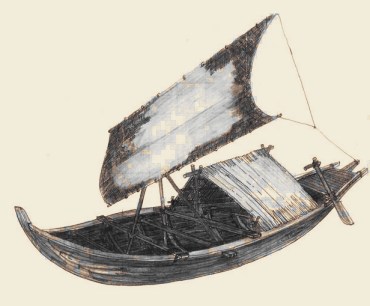
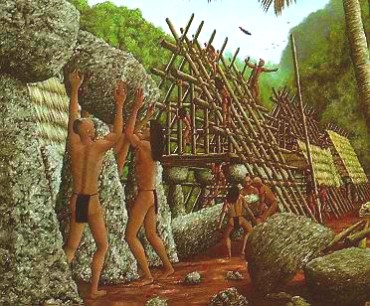
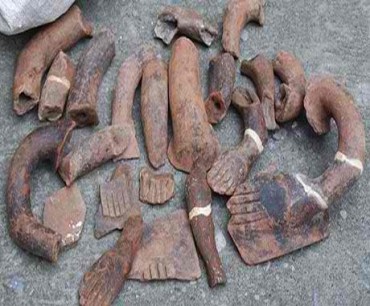
Pre-colonial era
| Date | Year | Cultural, natural, social and political events |
|---|---|---|
| - | 900 | Copper plate inscriptions (Laguna) show settlements in and around Manila |
| - | 1000 | Begin of trade with Chinese porcelain. Chinese traders set up bases in the Philippines. |
| - | 1200 - 1300 | Wave of immigrants from Borneo. Islam reaches the southern Philippines. |
| - | 1240 | Islamic missionaries in Sulu. Relatively peaceful mission among the tribes in the southern Philippines because islamic missionaries widely tolerate the traditions of the indigenous tribes . |
| - | 1250 | Legislation written by Datu Sumakwei on Panay island |
| - | 1380 | Sharif Makdon builds the first mosque on Sulu island |
| - | 1433 | Datu (chief) Kalantiaw of the island of Negros also publishes a law code. The Datu is at the head of the ruling aristocracy, followed by the honorary citizens (Maharlikas), the free citizens (Timaguas) and two groups of slaves (Alipin) |
| - | 1450 | Establishment of a Muslim sultanate on Jolo under Sultan Sharif ul-Hasim Abubakr |
| - | 1475 | Islam is spreading in Mindanao. Later it spreads up to Central Luzon |
| - | 1494 | By the Treaty of Tordesillas, Pope Alexander VI. divides the world between the two competing maritime powers Portugal and Spain. |
| - | 1511 | Portuguese conquer Malacca (now Malaysia) and establish an important trading post |
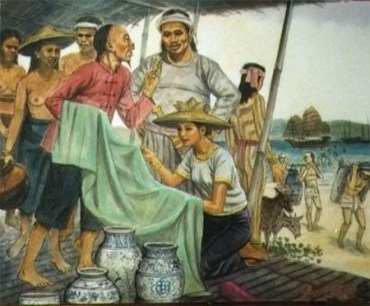
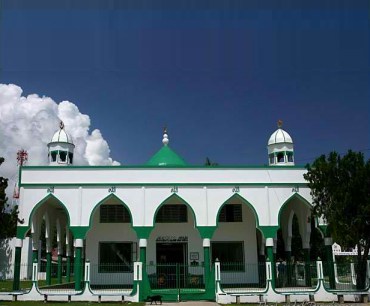
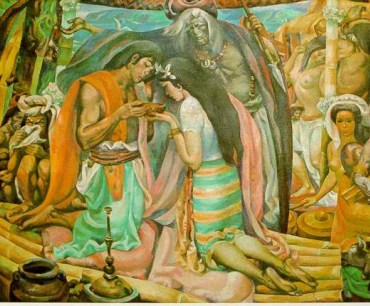
Spanish colonial period (1521 - 1898)
| Date | Year | Cultural, natural, social and political events |
|---|---|---|
| March 16 | 1521 | Ferdinand Magellan lands with three ships ("Conception", "Trinidad" and "Victoria") on the small island of Homohon (east of Samar). |
| March 29 | 1521 | Magellan On the island Limasawa, Magellan establishes a friendship treaty with the chief Rajah Kulambo |
| March 31 | 1521 | First Catholic Mass held in Limasawa |
| April 27 | 1521 | Magellan dies in battle of Mactan island against the later national hero - chieftain Lapu-Lapu. |
| February 2 | 1543 | Captain Ruy de Villalobos Lopez lands in the archipelago and names the islands after the Spanish Crown Prince Philipp II |
| February 2 | 1565 | Miguel Lopez de Legaspi reaches the Philippines with four ships and 380 men. In Cebu, he establishes the first permanent settlement of the Spaniards. He is the first Spanish governor-general in the Philippines. The following is a quick hand in hand walking of Christianity and Hispanization in large parts of the sparsely populated country (estimated population: 750,000) |
| - | 1569 | Beginning of the Galleon's trade (1569 - 1815) between China and Mexico. Manila is the hub of this trade of Mexican silver coins and Chinese silk, porcelain objects, pearls and spices. |
| June 24 | 1571 | Manila is proclaimed capital of the Philippines. Intramuros is the fortified part of town. |
| - | 1574 | The Chinese pirate Limahong attacks Manila twice, until he is defeated. |
| - | 1574 | Lakandula initiates first short-term revolt against the Spanish. |
| - | 1576 | Chinese are allowed to immigrate to the Philippines, but are still discriminated and expelled (riots against Chinese and others in 1603, 1639, 1662 and 1782) |
| - | 1590 | The Jesuits found the Colegeo de Manila, later called the "Universidad de San Ignacio" |
| - | 1600 -1670 | Several unsuccessful attempts by the Dutchmen, to conquer parts of the country |
| - | 1603 | Rise of the Chinese in Manila |
| - | 1611 | Opening of the Universidad de Santo Tomas, the oldest Catholic university in Asia |
| - | 1622 | Several revolts against the forced levy in Bohol, Leyte, Samar and Panay. Francisco Dagohoy is the leader of the revolt in Bohol which lasts over 85 years (1744-1829). |
| September 22 | 1762 | 6800 British soldiers with 13 ships attack Manila and takes it. |
| - | 1762 | In the province of Ilocos a revolt starts under Diego Silang because of the compulsory levy. The uprising is initially successful. The "independent and free Ilocos" is proclaimed. Silang is killed a year later by a former friend. His wife continues the fight, but is defeated and hanged along with other companions in 1763. |
| - | 1763 | Treaty of Paris ends the British occupation of parts of the Philippines (1764). |
| - | 1774 | Filipinos may become priests. |
| - | 1787 | Moro pirates plunder Bacolod on Negros Island. The attack on Bacolod is only a representative for many others. Until the first half of the 19th Century, Moro pirates attack villages in southern Luzon and the Visayas. |
| January 22 | 1809 | The Philippines become an integral part of Spain and Filipinos are given the Spanish nationality and a right of representation in the Spanish Parliament (1810-1837). Iin 1812, the liberal Cadiz constitution is adopted. Napoleon cancels this integration in 1816. |
| - | 1820 | Increasing agricultural production (tobacco, sugar cane, abaca) |
| - | 1828 | Strong earthquake which destroys buildings and churches in Manila. |
| - | 1835 | The first Philippine bank is established. |
| - | 1838 | The epic poem "Florante at Laura" by Francisco Balagtas is published |
| June 19 | 1861 | José Rizal is born in Calamba (Laguna Province). Rizal studied medicine, philosophy and literature at the Ateneo de Manila and the University of Santo Tomas in Manila. |
| - | 1863 | Reform of the education system. It allows now the Filipinos higher school qualifications. Wealthier families can finance studies in Spain. A numerically small, liberal-minded, educated middle class developes slowly. Also a small elite group of "Illustrados" is established. |
| - | 1863 | A powerful earthquake destroys most of the buildings in Manila (except the San Augustin church). |
| - | 1869 | The opening of the Suez Canal allows permanent maritime links between the Philippines and Spain. |
| - | 1873 | The German ethnologist Feodor Jagor published his book "Travels in the Philippines" |
| - | 1880 | First underwater telegraph cable to the Philippines |
| - | 1887 | Rizal's novel "Noli me tangere" is published in Madrid. |
| - | 1891 | Rizal's novel "El Filibusterismo" is published |
| June 26 | 1892 | Rizal returns to the Philippines |
| July 3 | 1892 | José Rizal founds the politically moderate, but anti-clerical "Liga Filipina". Andreas Bonifacio joins this elite league. |
| July 7 | 1892 | Rizal is arrested because of the creation of the "Liga Filipina. Without any court ruling he is sent in exile to Dapitan. |
| July 8 | 1892 | Bonifacio founds the secret society Katipunan. The covenant is based nationalist ideas and wants an to end the Spanish oppression. Unlike Rizal, the Katipunan accepts also the use of force. |
| August 19 | 1892 | The Katipunan-conspiracy is uncovered. Individual members are arrested, , however, most of them can take refuge in the hills of Balintawak. |
| August 23 | 1896 | Bonifacio anounces the Revolution ("Cry of Balintawak"). The followers burn their Spanish identity papers. |
| August 30 | 1896 | The outcry of the Katipunan spread across eight provinces. The Spanish general governor declares the state of war. |
| September 2 | 1896 | Rizal is falsely accused of having been the founder of the Katipunan. |
| December 30 | 1896 | José Rizal is executed. He becomes the national hero of the Philippines for future generations |
| April 29 | 1897 | Aguinaldo is elected President of the Katipunan. Bonifacio is elected minister of war. Bonifacio does not accept Aguinaldo position. |
| May 8 | 1897 | The Katipunero leaders accuse Bonifacio of sedition and treason and sentence him to death. |
| December 14 | 1897 | Because of the Spanish supremacy, Aguinaldo decides to negotiate with the Spaniards. In the pact of" Biak-na-Bato" the Katipuneros are commited to lay down their weapons if the Spanish authorities carry out reforms and respect the human rights. For a fee of 800,000 pesos, Aguinaldo agrees, to leave the Philippines with his companions for exile in Hong Kong. |
| February 8 | 1898 | The U.S. government asks Aguinaldo for support them in their struggle against the Spanish government. Aguinaldo agrees, because the Americans promise the independence of the Philippines for the help in the fight against Spain. |
| February 12 | 1898 | The United States of America declare war to Spain. |
| June 12 | 1898 | The Philippine's independency from Spain is proclaimed in Kawit, Cavite. Manila is still held by Spanish troops. The new Philippine flag is hoisted and the new national anthem being played. Tthe first Philippine Republic is born. |
| June 23 | 1898 | On the advice of Apolinario Mabini, the "dictatorial" government is converted in a "revolutionary" one, the "Malolos Republic". |
| July 17 | 1898 | The Americans, under General Wesley Merritt E. strengthen their military presence in the Philippines. Their attitude towards Filipinos changes and becomes worse. |
| December 10 | 1898 | In the Treaty of Paris, Spain sells the former Philippine colony for 20 million dollars to the Americans. This is the end of the Spanish colonial period of 333 years. |
